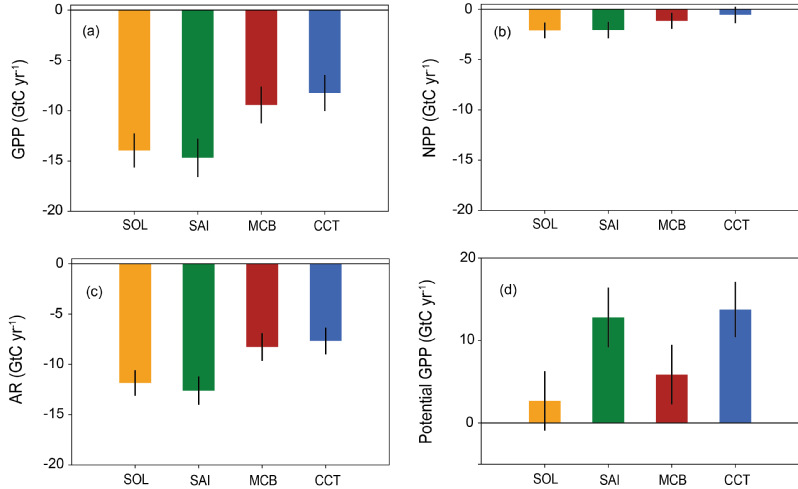Editor: 邵丹蕾 Author: DUAN LEI Time: 2020-04-30 Number of visits :150
A number of radiation modification approaches have been proposed to intentionally alter Earth’s radiation balance to counteract the anthropogenic warming. However, only a few studies have analyzed the potential impacts of these approaches on the terrestrial plant carbon cycle. Here we simulate four idealized radiation modification approaches, including direct decrease of the solar irradiance, increase of stratospheric sulfate aerosols concentration, enhancement of marine low cloud albedo and reduction of high-level cirrus cloud cover, and analyze the changes in plant photosynthesis and respiration. The first three approaches cool the earth by reducing incoming solar radiation and the last approach allows more outgoing thermal radiation. In our study, they are designed to offset the global mean warming caused by doubled atmospheric CO2. Compared to the high-CO2 world, all approaches will limit plant growth due to induced surface cooling in high latitudes and reduced nitrogen supply in low latitudes, leading to an overall reduction in the plant carbon absorption over land. Different approaches also produce different changes in surface direct and diffuse sunlight, which show important implications for the plant photosynthesis. Relative to the unperturbed climate, the combined effect of enhanced CO2 and radiation modifications leads to an increase in plant primary production.

Figure: Bar plots showing changes in (a) gross primary production (GPP), (b) net primary production (NPP), (c) autotrophic respiration (AR), and (d) potential GPP over land for various radiation modification approaches relative to the 2 × CO2 case. All results are calculated using the last 60 years of the 100‐year slab‐ocean simulations results. Uncertainties are reported as one standard deviation
This work was led by Dr. Lei Duan, who was a Ph.D. student at the School of Earth Sciences, Zhejiang University, and now a postdoctoral researcher in the Department of global ecology, Carnegie Institution. Other authors include Prof. Long Cao at the School of Earth Sciences, Zhejiang University, Prof. Govindasamy Bala at Center for Atmospheric and Oceanic Sciences, Indian Institute of Science, and senior scientist, Ken Caldeira in the Department of global ecology, Carnegie Institution.
For details: Duan, L., Cao, L., Bala, G., & Caldeira, K. (2020). A model‐based investigation of terrestrial plant carbon uptake response to four radiation modification approaches. Journal of Geophysical Research: Atmospheres, 125, e2019JD031883. https://doi.org/10.1029/2019JD031883
